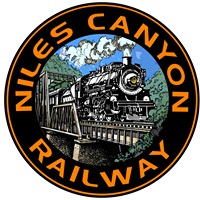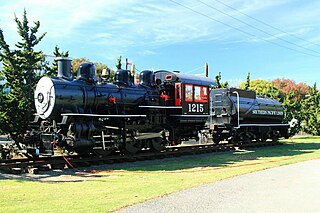
The Southern Pacific was an American Class I railroad network that existed from 1865 to 1996 and operated largely in the Western United States. The system was operated by various companies under the names Southern Pacific Railroad, Southern Pacific Company and Southern Pacific Transportation Company.

The Atchison, Topeka and Santa Fe Railway, often referred to as the Santa Fe or AT&SF, was one of the largest Class 1 railroads in the United States between 1859 and 1996.

The California State Railroad Museum is a museum in the California State Parks system that interprets the role of railroads in the West. It is located in Old Sacramento State Historic Park at 111 I Street, Sacramento, California.
The Golden Gate Railroad Museum is a non-profit railroad museum in California that is dedicated to the preservation of steam and passenger railroad equipment, as well as the interpretation of local railroad history.
The San Jose Steam Railroad Museum is a planned railroad museum within Santa Clara County that has been under development by California Trolley and Railroad Corporation since 1992. This project was originally intended to be located at the Santa Clara County Fairgrounds in San Jose, California; however in 2002, the Board of Supervisors voted to rescind support of the proposed railroad museum at that location. Since then, CTRC has been actively working with various public agencies for a suitable alternate site. The proposed location is near downtown San Jose.

The Niles Canyon Railway (NCRy) is a heritage railway running on the first transcontinental railroad alignment through Niles Canyon, between Sunol and the Niles district of Fremont in the East Bay of the San Francisco Bay Area, in California, United States. The railway is listed on the National Register of Historic Places as the Niles Canyon Transcontinental Railroad Historic District. The railroad is operated and maintained by the Pacific Locomotive Association which preserves, restores and operates historic railroad equipment. The NCRy features public excursions with both steam and diesel locomotives along a well-preserved portion of the first transcontinental railroad.

Southern Pacific 2472 is a P-8 Class 4-6-2 heavy "Pacific" type steam locomotive built by the Baldwin Locomotive Works for Southern Pacific Railroad (SP) in 1921. No. 2472 is one of three surviving Southern Pacific P-8 class 4-6-2 Pacific locomotives, the other two being Nos. 2467 and 2479. The 4-6-2 designation means it has four leading wheels, six driving wheels, and two trailing wheels. The locomotive was used by the Southern Pacific Railroad to haul passenger trains until being retired in 1957. The locomotive was then donated to San Mateo County and placed on static display at the San Mateo County Fairgrounds. After being restored to operational condition in the early 1990s, the locomotive would pull excursion trains on the Niles Canyon Railway until being retired in 2015. The No. 2472 was then moved to the Northwest Pacific Railroad, where it is as of 2023, undergoing its Federal Railroad Administration (FRA) mandated 1,472 day inspection and overhaul.

The Pacific Locomotive Association, Inc. (PLA) is a non-profit organization dedicated to the preservation of the physical aspects and atmosphere of Pacific Coast railroading during the period from 1910 to 1960.

The Peninsula Commute, also known as the Southern Pacific Peninsula or just Peninsula, was the common name for commuter rail service between San Jose, California and San Francisco, California on the San Francisco Peninsula. This service ran as a private, for-profit enterprise beginning in 1863. Due to operating losses, the Southern Pacific Railroad (SP) petitioned to discontinue the service in 1977. Subsidies were provided through the California Department of Transportation (Caltrans) in 1980 to continue service, and it was renamed Caltrain.

An oil burner engine is a steam engine that uses oil as its fuel. The term is usually applied to a locomotive or ship engine that burns oil to heat water, to produce the steam which drives the pistons, or turbines, from which the power is derived.

Southern Pacific 1215 is a preserved 0-6-0 switcher steam locomotive. It was built by Baldwin in 1913, and it was primarily used to switch rolling stock in rail yards, until it was removed from the Southern Pacific's active roster in 1957. It subsequently spent thirty-seven years on static display in Hanford, California until 1995, when it was removed from display while going through a few ownership changes. As of 2022, the locomotive is owned by the California Trolley and Railroad Corporation, and No. 1215 is displayed in San Jose, California.

Established in 1982, the California Trolley and Railroad Corporation (CTRC) is a 501(c)(3) non-profit organization to preserve rail transportation in the Santa Clara Valley.

Southern Pacific 9010 is a KM ML 4000 C'C' diesel-hydraulic locomotive, built in 1964 by German manufacturer Krauss-Maffei for the Southern Pacific Railroad. SP 9010 generated 4,000 horsepower (3,000 kW) from two 2,000-horsepower (1,500 kW) V16 Maybach MD870 diesel engines. It was painted to Southern Pacific's 1958 standard, the so-called "bloody nose" colors of Scarlet and Lark Dark Gray, for its entire operating career. It was renumbered to SP 9113 in late 1965, rebuilt extensively at SP's Sacramento General Shops during the latter half of 1966, and was initially retired in 1968. It was revived and rebuilt by Sacramento General Shops into a "camera car" for the purpose of shooting motion picture background plates for a ground-based full-motion locomotive training simulator. As camera car number 8799, it was retired in 1984 and donated to the California State Railroad Museum in Sacramento, California. It was de-accessioned by CSRM and acquired by the Pacific Locomotive Association and moved to the Niles Canyon Railway's Brightside, California rail yard in the summer of 2008. At the date of its inception, its type represented the highest-horsepower six-axle diesel locomotives in the world. SP 9010 is the sole surviving ML 4000 C'C' built for use in North America, and the sole surviving mainline diesel-hydraulic locomotive in North America..

The Krauss-Maffei ML 4000 is a road switcher diesel-hydraulic locomotive, built between 1961 and 1969 by German manufacturer Krauss-Maffei in Munich, Germany. It generated 3,540 horsepower (2,640 kW) from two Maybach V16 engines. 37 examples were built for two North American railroads and one South American railroad.

Southern Pacific Railroad 2467 is a preserved 4-6-2 “Pacific” type steam locomotive. Built by Baldwin in 1921, it was used by the Southern Pacific Railroad to pull passenger trains until it was retired from service in 1956. On July 25, 1960, it was donated to the city of Oakland, California, who had it placed on display at the Harrison Railroad Park. In July 1990 a restoration began by the Friends of the 2467, which later merged into the Pacific Locomotive Association. In June 1999 it was returned to operation and made an appearance at Railfair 1999. Although serviceable, SP 2467 is currently on static display while on loan from its operator, Pacific Locomotive Association, Inc., to the California State Railroad Museum in Sacramento, California.

The Southern California Railway Museum, formerly known as the Orange Empire Railway Museum, is a railroad museum in Perris, California, United States. It was founded in 1956 at Griffith Park in Los Angeles before moving to the former Pinacate Station as the "Orange Empire Trolley Museum" in 1958. It was renamed "Orange Empire Railway Museum" in 1975 after merging with a museum then known as the California Southern Railroad Museum, and adopted its current name in 2019. The museum also operates a heritage railroad on the museum grounds.

Southern Pacific No. 1744 is a preserved American class "M-6" 2-6-0 "Mogul" type steam locomotive built by the Baldwin Locomotive Works for the Southern Pacific Railroad in November 1901. Originally equipped with Vauclain compound cylinders, it was rebuilt with conventional cylinders in 1912. It operated for many years out of Oakland, California on the Southern Pacific's Western Division and in California's Central Valley where the locomotive and its classmates were fondly called “Valley Mallets” by their crews. The locomotive was made famous in later years by pulling some of the last steam excursions on the SP alongside other steam locomotives, including 4-8-4 4460. In 1959, No. 1744 was donated to the Sons of Utah Pioneers in Corinne, Utah where it remained on static display, until 1980. That year, it was restored by New London Railroad and Village Incorporated to operate on the Heber Valley Railroad in Heber City for the rest of the decade.

The San Jose Railroads was a street railway operator in San Jose, from 1912 until April 10, 1938

The Southern Pacific Class P-8 was a class of 4-6-2 "Pacific" type steam locomotives that were built by the Baldwin Locomotive Works for the Southern Pacific Transportation Company in 1921.


















